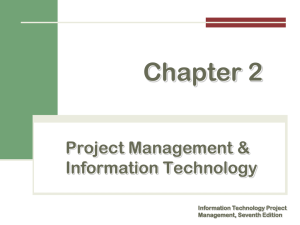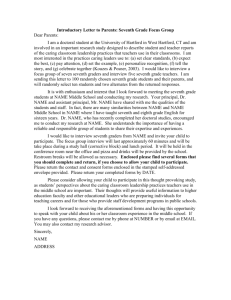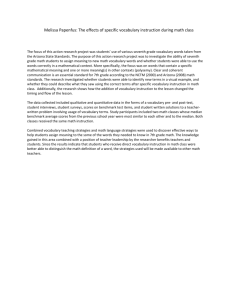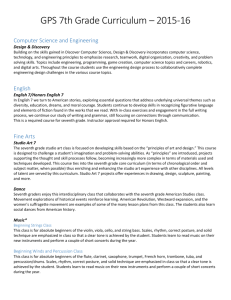Information Technology Project Management
advertisement
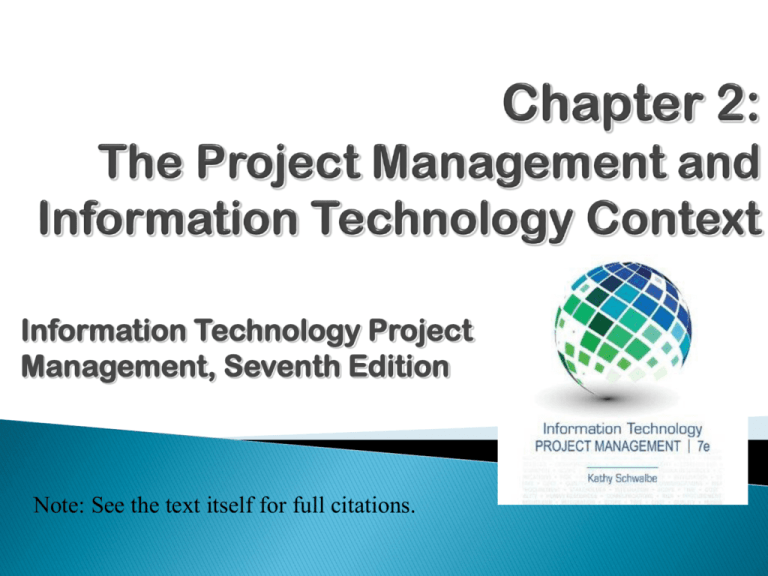
Information Technology Project Management, Seventh Edition Note: See the text itself for full citations. Describe the systems view of project management and how it applies to information technology (IT) projects Understand organizations, including the four frames, organizational structures, and organizational culture Explain why stakeholder management and top management commitment are critical for a project’s success Information Technology Project Management, Seventh Edition Copyright 2014 2 Understand the concept of a project phase and the project life cycle, and distinguish between project development and product development Discuss the unique attributes and diverse nature of IT projects Describe recent trends affecting IT project management, including globalization, outsourcing, virtual teams, and agile project management Information Technology Project Management, Seventh Edition Copyright 2014 3 Projects must operate in a broad organizational environment Project managers need to use systems thinking: ◦ taking a holistic view of carrying out projects within the context of the organization Senior managers must make sure projects continue to support current business needs Information Technology Project Management, Seventh Edition Copyright 2014 4 A systems approach emerged in the 1950s to describe a more analytical approach to management and problem solving Three parts include: ◦ Systems philosophy: an overall model for thinking about things as systems ◦ Systems analysis: problem-solving approach ◦ Systems management: address business, technological, and organizational issues before making changes to systems Information Technology Project Management, Seventh Edition Copyright 2014 5 Information Technology Project Management, Seventh Edition Copyright 2014 6 Information Technology Project Management, Seventh Edition Copyright 2014 7 • In a paper titled “A Study in Project Failure,” two researchers examined the success and failure of 214 IT projects over an eight-year period in several European countries. • The researchers found that only one in eight (12.5 percent) were considered successful in terms of meeting scope, time, and cost goals. • The authors said that the culture within many organizations is often to blame • Among other things, people often do not discuss important leadership, stakeholder, and risk management issues Information Technology Project Management, Seventh Edition Copyright 2014 8 3 basic organization structures ◦ Functional: functional managers report to the CEO ◦ Project: program managers report to the CEO ◦ Matrix: middle ground between functional and project structures; personnel often report to two or more bosses; structure can be weak, balanced, or strong matrix Information Technology Project Management, Seventh Edition Copyright 2014 9 Information Technology Project Management, Seventh Edition Copyright 2014 10 Information Technology Project Management, Seventh Edition Copyright 2014 11 Organizational culture is a set of shared assumptions, values, and behaviors that characterize the functioning of an organization Many experts believe the underlying causes of many companies’ problems are not the structure or staff, but the culture Information Technology Project Management, Seventh Edition Copyright 2014 12 Member identity* Group emphasis* People focus Unit integration* Control Risk tolerance* Reward criteria* Conflict tolerance* Means-ends orientation Open-systems focus* *Project work is most successful in an organizational culture where these items are strong/high and other items are balanced. Information Technology Project Management, Seventh Edition Copyright 2014 13 Project managers must take time to identify, understand, and manage relationships with all project stakeholders Using the four frames of organizations can help meet stakeholder needs and expectations Senior executives/top management are very important stakeholders See Chapter 13, Project Stakeholder Management, for more information Information Technology Project Management, Seventh Edition Copyright 2014 14 The media have often reported on mismanaged IT projects. A classic example and popular case study is the baggage handling system at Denver International Airport (DIA). The system was supposed to reduce flight delays, shorten waiting times at luggage carousels, and save money, but instead it caused huge problems. One important reason for this famous project disaster was the failure to recognize the project’s complexity. Information Technology Project Management, Seventh Edition Copyright 2014 15 People in top management positions are key stakeholders in projects A very important factor in helping project managers successfully lead projects is the level of commitment and support they receive from top management Without top management commitment, many projects will fail. Some projects have a senior manager called a champion who acts as a key proponent for a project. Information Technology Project Management, Seventh Edition Copyright 2014 16 Providing adequate resources Approving unique project needs in a timely manner Getting cooperation from other parts of the organization Mentoring and coaching on leadership issues Information Technology Project Management, Seventh Edition Copyright 2014 17 IT governance addresses the authority and control for key IT activities in organizations, including IT infrastructure, IT use, and project management A lack of IT governance can be dangerous, as evidenced by three well-publicized IT project failures in Australia (Sydney Water’s customer relationship management system, the Royal Melbourne Institute of Technology’s academic management system, and One.Tel’s billing system) Information Technology Project Management, Seventh Edition Copyright 2014 18 If the organization has a negative attitude toward IT, it will be difficult for an IT project to succeed Having a Chief Information Officer (CIO) at a high level in the organization helps IT projects Assigning non-IT people to IT projects also encourage more commitment Information Technology Project Management, Seventh Edition Copyright 2014 19 Standards and guidelines help project managers be more effective Senior management can encourage ◦ the use of standard forms and software for project management ◦ the development and use of guidelines for writing project plans or providing status information ◦ the creation of a project management office or center of excellence Information Technology Project Management, Seventh Edition Copyright 2014 20 A project life cycle is a collection of project phases that defines ◦ ◦ ◦ ◦ what work will be performed in each phase what deliverables will be produced and when who is involved in each phase, and how management will control and approve work produced in each phase A deliverable is a product or service produced or provided as part of a project Information Technology Project Management, Seventh Edition Copyright 2014 21 In early phases of a project life cycle ◦ resource needs are usually lowest ◦ the level of uncertainty (risk) is highest ◦ project stakeholders have the greatest opportunity to influence the project In middle phases of a project life cycle ◦ the certainty of completing a project improves ◦ more resources are needed The final phase of a project life cycle focuses on ◦ ensuring that project requirements were met ◦ the sponsor approves completion of the project Information Technology Project Management, Seventh Edition Copyright 2014 22 Information Technology Project Management, Seventh Edition Copyright 2014 23 Products also have life cycles The Systems Development Life Cycle (SDLC) is a framework for describing the phases involved in developing and maintaining information systems Systems development projects can follow ◦ Predictive life cycle: the scope of the project can be clearly articulated and the schedule and cost can be predicted ◦ Adaptive Software Development (ASD) life cycle: requirements cannot be clearly expressed, projects are mission driven and component based, using time-based cycles to meet target dates Information Technology Project Management, Seventh Edition Copyright 2014 25 Waterfall model: has well-defined, linear stages of systems development and support Spiral model: shows that software is developed using an iterative or spiral approach rather than a linear approach Incremental build model: provides for progressive development of operational software Prototyping model: used for developing prototypes to clarify user requirements Rapid Application Development (RAD) model: used to produce systems quickly without sacrificing quality Information Technology Project Management, Seventh Edition Copyright 2014 26 Information Technology Project Management, Seventh Edition Copyright 2014 27 Agile software development has become popular to describe new approaches that focus on close collaboration between programming teams and business experts See the last section of this chapter and Chapter 3 for more information on agile Information Technology Project Management, Seventh Edition Copyright 2014 28 A project should successfully pass through each of the project phases in order to continue on to the next Management reviews, also called phase exits or kill points, should occur after each phase to evaluate the project’s progress, likely success, and continued compatibility with organizational goals Information Technology Project Management, Seventh Edition Copyright 2014 29 "The real improvement that I saw was in our ability toin the words of Thomas Edisonknow when to stop beating a dead horse.…Edison's key to success was that he failed fairly often; but as he said, he could recognize a dead horse before it started to smell...In information technology we ride dead horsesfailing projectsa long time before we give up. But what we are seeing now is that we are able to get off them; able to reduce cost overrun and time overrun. That's where the major impact came on the success rate.”* Many organizations, like Huntington Bancshares, Inc., use an executive steering committee to help keep projects on track. *Cabanis, Jeannette, "'A Major Impact': The Standish Group's Jim Johnson On Project Management and IT Project Success," PM Network, PMI, Sep.1998, p. 7 Information Technology Project Management, Seventh Edition Copyright 2014 30 IT projects can be very diverse in terms of size, complexity, products produced, application area, and resource requirements IT project team members often have diverse backgrounds and skill sets IT projects use diverse technologies that change rapidly. Even within one technology area, people must be highly specialized Information Technology Project Management, Seventh Edition Copyright 2014 31 Globalization Outsourcing: Outsourcing is when an organization acquires goods and/or sources from an outside source. Offshoring is sometimes used to describe outsourcing from another country Virtual teams: A virtual team is a group of individuals who work across time and space using communication technologies Agile project management Information Technology Project Management, Seventh Edition Copyright 2014 32 Issues ◦ ◦ ◦ ◦ Communications Trust Common work practices Tools Suggestions ◦ ◦ ◦ ◦ Employ greater project discipline Think global but act local Keep project momentum going Use newer tools and technology Information Technology Project Management, Seventh Edition Copyright 2014 33 Organizations remain competitive by using outsourcing to their advantage, such as finding ways to reduce costs Their next challenge is to make strategic IT investments with outsourcing by improving their enterprise architecture to ensure that IT infrastructure and business processes are integrated and standardized (See Suggested Readings) Project managers should become more familiar with negotiating contracts and other outsourcing issues Information Technology Project Management, Seventh Edition Copyright 2014 34 Outsourcing also has disadvantages. For example, Apple benefits from manufacturing products in China, but it had big problems there after its iPhone 4S launch in January 2012 caused fighting between migrant workers who were hired by scalpers to stand in line to buy the phones. When Apple said it would not open its store in Beijing, riots resulted and people attacked security guards. The Beijing Apple Store has had problems before. In May 2011, four people were injured when a crowd waiting to buy the iPad 2 turned ugly. Information Technology Project Management, Seventh Edition Copyright 2014 35 Increasing competiveness and responsiveness by having a team of workers available 24/7 Lowering costs because many virtual workers do not require office space or support beyond their home offices. Providing more expertise and flexibility by having team members from across the globe working any time of day or night Increasing the work/life balance for team members by eliminating fixed office hours and the need to travel to work. Information Technology Project Management, Seventh Edition Copyright 2014 36 Isolating team members Increasing the potential for communications problems Reducing the ability for team members to network and transfer information informally Increasing the dependence on technology to accomplish work See text for a list of factors that help virtual teams succeed, including team processes, trust/relationships, leadership style, and team member selection Information Technology Project Management, Seventh Edition Copyright 2014 37 Agile means being able to move quickly and easily, but some people feel that project management, as they have seen it used, does not allow people to work quickly or easily. Early software development projects often used a waterfall approach, as defined earlier in this chapter. As technology and businesses became more complex, the approach was often difficult to use because requirements were unknown or continuously changing. Agile today means using a method based on iterative and incremental development, in which requirements and solutions evolve through collaboration. Information Technology Project Management, Seventh Edition Copyright 2014 38 Many seasoned experts in project management warn people not to fall for the hype associated with Agile. For example, J. Leroy Ward, Executive Vice President at ESI International, said that “Agile will be seen for what it is … and isn’t….Project management organizations embracing Agile software and product development approaches will continue to grow while being faced with the challenge of demonstrating ROI through Agile adoption.”* *J. Leroy Ward, “The Top Ten Project Management Trends for 2011,” projecttimes.com (January 24, 2011). Information Technology Project Management, Seventh Edition Copyright 2014 39 In February 2001, a group of 17 people that called itself the Agile Alliance developed and agreed on the Manifesto for Agile Software Development, as follows: “We are uncovering better ways of developing software by doing it and helping others do it. Through this work we have come to value: Individuals and interactions over processes and tools Working software over comprehensive documentation Customer collaboration over contract negotiation Responding to change over following a plan”* *Agile Manifesto, www.agilemanifesto.org. Information Technology Project Management, Seventh Edition Copyright 2014 40 According to the Scrum Alliance, Scrum is the leading agile development method for completing projects with a complex, innovative scope of work. The term was coined in 1986 in a Harvard Business Review study that compared highperforming, cross-functional teams to the scrum formation used by rugby teams. Information Technology Project Management, Seventh Edition Copyright 2014 41 Information Technology Project Management, Seventh Edition Copyright 2014 42 The PMBOK® Guide describes best practices for what should be done to manage projects. Agile is a methodology that describes how to manage projects. The Project Management Institute (PMI) recognized the increased interest in Agile, and introduced a new certification in 2011 called Agile Certified Practitioner (ACP). Seasoned project managers understand that they have always had the option of customizing how they run projects, but that project management is not easy, even when using Agile. Information Technology Project Management, Seventh Edition Copyright 2014 43 Project managers need to take a systems approach when working on projects Organizations have four different frames: structural, human resources, political, and symbolic The structure and culture of an organization have strong implications for project managers Projects should successfully pass through each phase of the project life cycle Project managers need to consider several factors due to the unique context of information technology projects Recent trends affecting IT project management include globalization, outsourcing, virtual teams, and Agile Information Technology Project Management, Seventh Edition Copyright 2014 44

